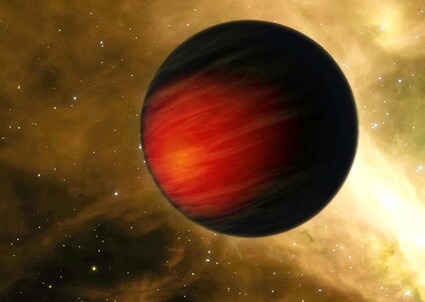Stars over Sisters 6/04/2019
Last updated 6/4/2019 at Noon

courtesy NASA/JPL
An artist’s depiction of a massive, super-hot exoplanet orbiting a star in the constellation of Corona Borealis.
With the arrival of summer just around the corner, it is not unreasonable to expect warmer temperatures and clearer skies to make viewing a parade of upcoming celestial events a pleasant one. True, we get a late start for evening observing because of Daylight Saving Time, but that’s not likely to change until enough people decide to do away with the unnecessary ritual.
The Summer Solstice does indeed arrive later this month — on June 21 at 8:54 a.m. PDT to be exact. On that day the sun will be directly overhead at local noon on the Tropic of Cancer (latitude of 23.5 degrees north). Another way to look at it is the axis of rotation of the earth will point toward the sun at that time. Either way, the result will produce the longest period of daylight of the year.
June’s lunar cycle definitely favors dark-sky viewing early in the month. By June 9 a waxing first quarter phase will brighten the night sky considerably. On June 17 the moon will be at its brightest as the full Strawberry Moon arrives on the scene. Dark evening skies return at the end of the month after the last quarter phase on June 25.
The featured constellation for this month lies between a herdsman (Bootes) and a strong man (Hercules). Though Corona Borealis takes up a small area on the celestial sphere, the shape made by its brightest stars actually resembles the object it represents, a crown, more specifically the Northern Crown. The semicircle of seven stars is easy to recognize and is nearly overhead in June.
There are several mythological stories associated with the celestial crown.
One of the more interesting tales is a Greek legend that involves Theseus, son of the King of Athens, who was confined in the famous labyrinth of Crete as prey to the ferocious Minotaur, a half-man-half-bull monster that lived there.
To appease the Minotaur, each year the Athenians offered up a number of their young men and maidens — and the King’s son was next in line.
But instead, Theseus vowed to kill the beast.
Ariadne, his loved one, gave him a sword and a spool of thread.
Unwinding the thread as he penetrated the winding paths of the labyrinth, he encountered the monster and slew it, then retraced his steps with the aid of the thread to make his escape.
Although Theseus married Ariadne, he later deserted her. As an act of pity the gods gave her a beautiful crown, which, on her death, was placed in the sky. Ariadne’s Crown still adorns the night skies of summer.
On May 12, 1866, a brilliant star suddenly appeared very close to Epsilon Coronae Borealis, one of the stars in the crown. Known as the “Blaze Star,” it was visible to the unaided eye for only eight days before fading to 10th magnitude. It flared again in 1946. Today the star is known as a recurring nova.
Exoplanets (those beyond our solar system) have been confirmed in five star systems within the constellation. Perhaps the largest is a hot super-giant with a mass 6.7 times greater than Jupiter orbiting the star Epsilon Coronae Borealis. Discovered in 2012, it has an orbital period of 418 days and lies at a distance of 221 light-years.
As the month begins, Mercury and Mars are the only two planets in the evening sky. On June 17 they will lie side by side in the evening twilight about 45 minutes after sunset, separated by only half a degree. Jupiter officially becomes an evening planet after its opposition on June 10. The morning planets early in June are Saturn, rising about 11 p.m. local Daylight Saving Time, and dazzling Venus coming up approximately an hour before sunrise.
















Reader Comments(0)